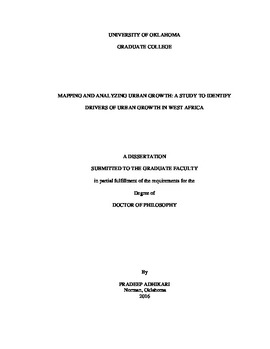| dc.description.abstract | Urban area expansion is one of the most powerful anthropogenic forces changing the earth‘s surface. Such changes are happening at much faster rates in African and Asian cities. Several interconnected but distinct processes like increase in population concentration and extensive alteration of the landscape are associated with urban area expansion. Therefore, understanding the urban area expansion and its drivers is a key task to devise a plan for sustainable urban development. In this study we mapped and analyzed urban area growth of six mid to large size cities of West Africa.
In land cover studies, growth in urban land use are characterized by the declines in cropland. So, firstly we evaluated twelve freely available, remotely sensed land cover and land use (LCLU) datasets at the eco-region, country, and pixel levels in West Africa to estimate croplands. The result shows a very high variability of estimated cropland at all levels. Despite this variability, datasets having a finer spatial resolution and representing a similar time period—specifically data from the International Institute for Applied Systems Analysis-International Food Policy Research Institute (IIASA-IFPRI), Global Land Cover-SHARE(GLC-SHARE), Moderate Resolution Imaging Spectroradiometer-UMD (MODIS-UMD), Global Cropland Extent, Moderate Resolution Imaging Spectroradiometer-UMD (MODIS-IGBP), and GLOBCOVER (GlobCover V23)—estimated comparable cropland areas at eco-region and country levels. The countrywide cropland area, obtained from the selected datasets, when compared with the sum of arable land and permanent crop area obtained from the Food and Agriculture Organization (FAO), showed high coefficient of determination (R2>0.95) for IIASA-IFPRI, and GLC-SHARE. At the pixel level, at the original resolution, the newer datasets have a comparable user’s accuracy (UA>53%) and producer’s accuracy (PA>46%), except for the Global Cropland Extent data. Overall, two datasets – IIASA-IFPRI and GLC-SHARE– performed better in the region to estimate the cropland area at all levels.
Next, we used Landsat MSS, TM and ETM+ images to map the urban land area in six West African cities for four different time steps from the early-1970s to 2010. The selected cities are Kumasi of Ghana, Daloa of Cote d’Ivoire, Abuja and Kano in Nigeria, Kindia of Guinea, and Ouagadougou of Burkina Faso. They also represent three different eco-regions: Eastern Guinean Forest, Guinean Forest-Savanna Mosaic, and West Sudanian Savanna of West Africa. We found that all the cities, except Daloa, have a large number of non-urban pixel converted to urban in the past three to four decades. The growth of the urban areas was high, 13 to 54%, but the growth trajectories were not consistent. For example, the rate of urban growth has been declining in Abuja and Ouagadougou in recent years while Kumasi has been growing consistently at a much higher rate since 1975 and was still growing about 13% annually, between 2005 and 2010. Also, most of the cities have shown a higher rate of growth of urban land use than population except Abuja and Ouagadougou. These cities revealed higher population growth, (10.7 to 15.8%) than urban land use growth, which varies from 3.0 to 4.5%. We did not observe any similarities in the growth of cities from the same eco-region.
Finally, we identified that Normalized Difference Vegetation Index (NDVI) and distance to the urban area showed strong associations with the growth of six cities in West Africa. The six cities include Kumasi, Daloa, Abuja, Kindia, Ouagadougou, and Kano. We found that none of the factors showed a consistent association with urban land use. Out of the six cities, Ouagadougou and Kano showed some level of agreement in associating the urban growth with NDVI at different time periods. In the rest of the cities, proximity parameters such as distance to the nearest urban area and distance to the core city area showed some level of association to urban growth. These findings shows that the process of conversion of urban land use is unique for a city at a given time period. | en_US |
